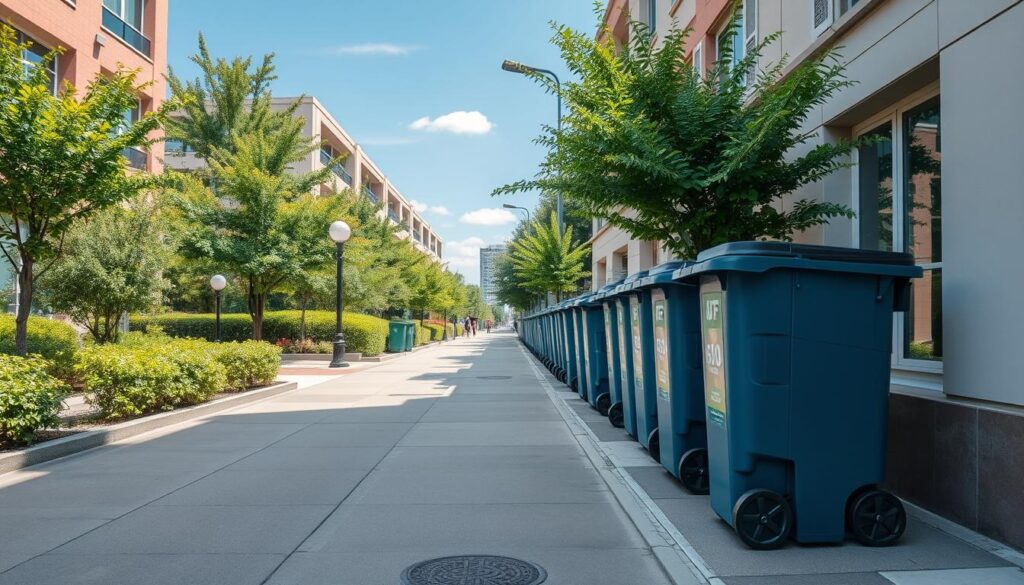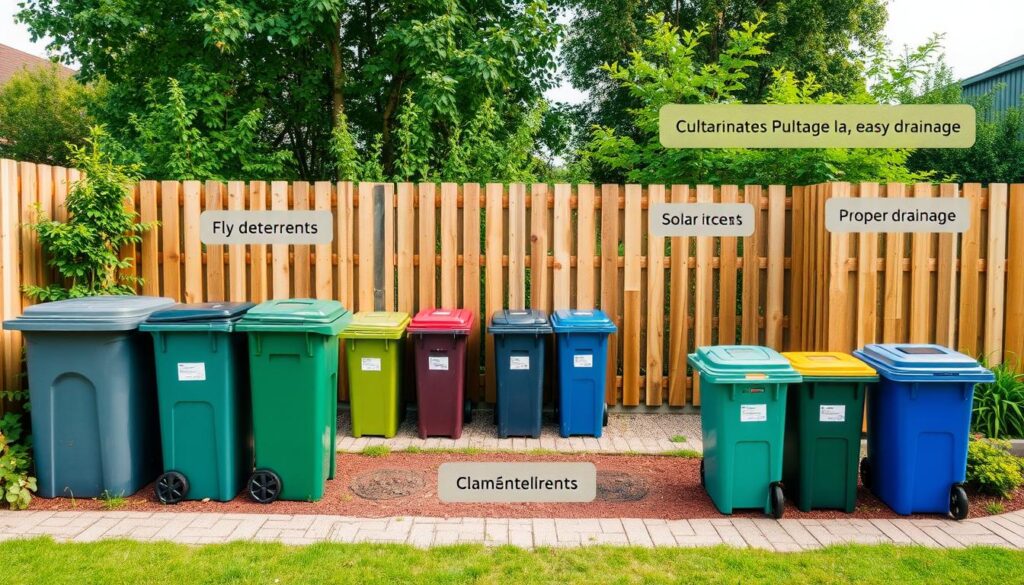Do your wheelie bins attract swarms of flies? The way you place your bins can help keep your outdoor space clean. We’ll look at how to position your bins to cut down on flies and make waste management easier.
Key Takeaways
- Properly placed wheelie bins can significantly reduce fly attraction and infestation issues.
- Accessibility, visibility, and security are crucial factors to consider when positioning your bins.
- Bin storage design and maintenance play a vital role in preventing fly problems.
- Regular cleaning, odour control, and responsible waste disposal practices are essential for minimising fly infestations.
- Innovative solutions and community campaigns can help address fly issues related to wheelie bin placement and management.
Understanding the Importance of Proper Wheelie Bin Placement
Wheelie bins are key in waste management in the UK. They keep places clean and help the environment. But, where we put them is very important.
It helps stop flies and keeps everyone healthy. It also helps the area around us stay clean.
Why Flies are Attracted to Wheelie Bins
Flies like the smell of waste in wheelie bins. They can smell yeast and rotting food from far away. Female flies lay many eggs that turn into maggots.
This leads to a big fly problem.
The Environmental and Health Impacts of Fly Infestations
Flies around bins are not just a bother. They can spread diseases like salmonella and typhoid fever. They also make waste pollute the area.
This harms the environment and makes places dirty.
“Effective waste disposal and wheelie bin management are essential to maintain cleanliness and hygiene in our communities.”
Putting bins in the right place is key. It stops flies and keeps people healthy. It also keeps our area clean.
Key Factors to Consider for Strategic Wheelie Bin Placement
When placing your wheelie bins, think about convenience, security, and how easy they are to get to. This helps your waste management system work well for you and the collectors.
Accessibility and Convenience
Put your bins near each building entrance and on main paths. This makes it easy for people to throw away their trash. It also helps the waste trucks pick up the bins quickly.
This convenient bin placement is good for your home and the waste trucks.
Visibility and Security
Place bins where they can be seen to stop misuse. But, you might also need to hide them or lock them up. This keeps your bins safe and visible.
Using barriers and access points helps manage your bin area well. It keeps your bins safe and easy to see.
| Key Considerations | Importance |
|---|---|
| Bin Placement Accessibility | Ensures convenient waste disposal for residents and efficient collection by refuse vehicles |
| Bin Storage Location | Balances visibility to deter unauthorised use with the need for screening and controlled access |
| Resident Convenience | Encourages responsible waste management by making it easy for residents to dispose of their refuse |
| Waste Collection Logistics | Enables refuse collectors to access and service wheelie bins efficiently |
| Bin Visibility | Promotes accountability and discourages misuse, while potentially requiring screening for aesthetics |
| Bin Security | Prevents unauthorised access and use through the use of physical barriers and controlled access points |
“Proper bin placement is crucial for maintaining a clean and organised community. By considering accessibility, visibility and security, you can create a waste management system that works for everyone.”

Wheelie bin placement
Putting your wheelie bins in the right place is key for a clean neighbourhood. Think about bin size and how they get collected. Also, make sure waste is sorted properly.
First, check what your local council says. They usually ask you to put bins out the night before, not too early. And not too late on the day of collection. This keeps things smooth for everyone.
If your bin is always full, think about getting more or bigger ones. Many councils will give you a free recycling bin. This helps cut down on landfill waste.
- Make sure bins are easy for collectors to reach.
- Place bins so they don’t block the way or parking.
- Put your house number on bins so they can be found if lost.
Planning where to put your bins makes waste collection better. It also keeps your outdoor area looking nice. Being kind to neighbours and following local rules helps keep everyone happy and clean.
| Bin Positioning Considerations | Benefits |
|---|---|
| Easily accessible for collection crews | Ensures timely and efficient waste removal |
| Bins placed to avoid obstructing pavements or parking | Maintains public safety and accessibility |
| Bins clearly labelled with house number | Helps identify bins in case of loss or mix-ups |
“By planning the placement of your wheelie bins, you can improve waste collection efficiency and maintain a tidy, visually appealing outdoor space.”
Design Considerations for Effective Wheelie Bin Storage Areas
Making a good wheelie bin storage area is key for a better outdoor space. Think about waste segregation, easy layout, and easy access.
Segregation and Ease of Use
Design your bin area for clear waste management. Use barriers or sections to keep waste types separate. This stops waste mixing and makes disposal better.
Also, make bins easy to reach and use. This means bins that are the right height and easy to open.
Aesthetics and Maintenance
The look of your bin area matters too. Use low-maintenance materials and smart design for a nice look. Choose materials that last and look good.
Adding plants can make it look even better. Or try bin store camouflage for a unique look. Keeping it clean is also important for a nice bin area.
| Design Consideration | Key Factors |
|---|---|
| Waste Segregation |
|
| User-Friendly Layout |
|
| Aesthetics and Maintenance |
|

“Designing an effective wheelie bin storage area is not just about functionality; it’s about creating a harmonious outdoor space that enhances the overall aesthetic and user experience.”
Tips for Preventing Fly Infestations Around Wheelie Bins
Keeping your wheelie bin clean and smell-free is key to stopping flies. Use a mix of tap water and white vinegar to clean it. This gets rid of smells that flies like.
Adding baking soda or charcoal to your cleaning helps too. They soak up bad smells, keeping your bin smelling fresh.
For extra help, try using essential oils like ginger or cinnamon around your bin. These natural sprays keep flies away. Also, make sure the area is dry and well-ventilated. Flies don’t like dry places.
Proper Waste Disposal Practices
Don’t put food waste in your wheelie bin. Use a kitchen composter or an Lomi system instead. They turn food scraps into compost fast, stopping flies from coming.
When you do use your bin, make sure bin liners are tight. Try using biodegradable bags or newspaper to line it. These help keep moisture and smells down.
“Properly securing garbage bags and using biodegradable options can go a long way in preventing fly infestations around your wheelie bin.”
By following these easy tips, you can cut down fly problems. Keep your wheelie bin area clean and free from pests.
Innovative Solutions and Campaigns Addressing Fly Issues
Organisations like Keep Britain Tidy and Hubbub are fighting litter and fly problems. They use creative ways to stop people from littering. This includes making waste disposal easier and more appealing.
“Ballot bins” are a clever idea. They are ashtrays with fun questions. Smokers vote by throwing away their butts. This has cut cigarette litter by 46% in Copenhagen.
Apps like Love Clean Streets let people report litter. This makes everyone feel they can help keep things clean. LitterLotto also rewards people for throwing away litter right.
Hubbub wants to teach people about littering’s harm. They found most don’t know cigarette butts are plastic. Knowing this might make people throw them away properly.
These efforts show how we can fight litter and fly problems. They use smart ideas and get people involved.
Conclusion
Using a smart plan for where you put your wheelie bins helps keep flies away. Make sure bins don’t block paths or driveways. Also, put them out on the right day for collection.
Following recycling rules and keeping bins clean is also key. Talking to your neighbours about waste can make your area cleaner. Wheelie bins have made streets safer and helped workers avoid injuries.
Focus on where you place your bins and how you dispose of waste. Working with your community can make your area cleaner and safer. Let’s all help keep our homes and streets tidy and green.
